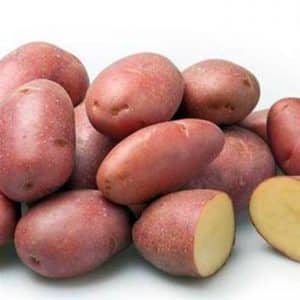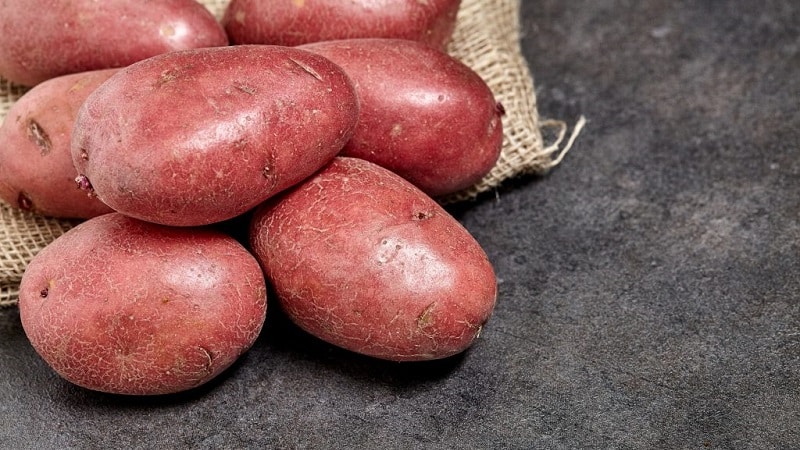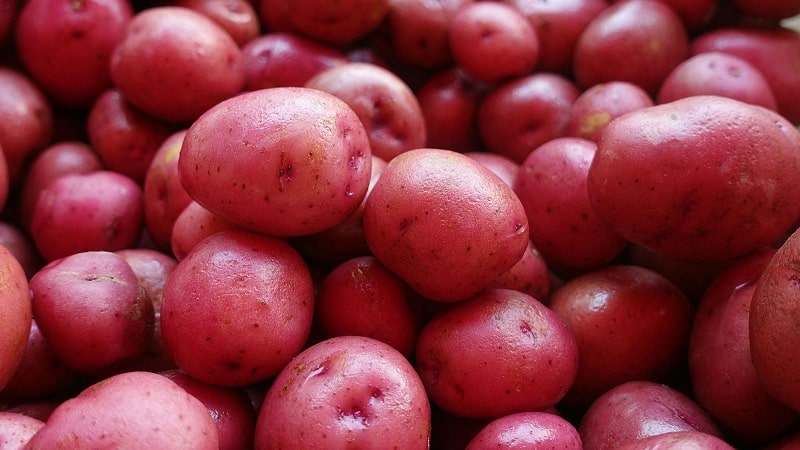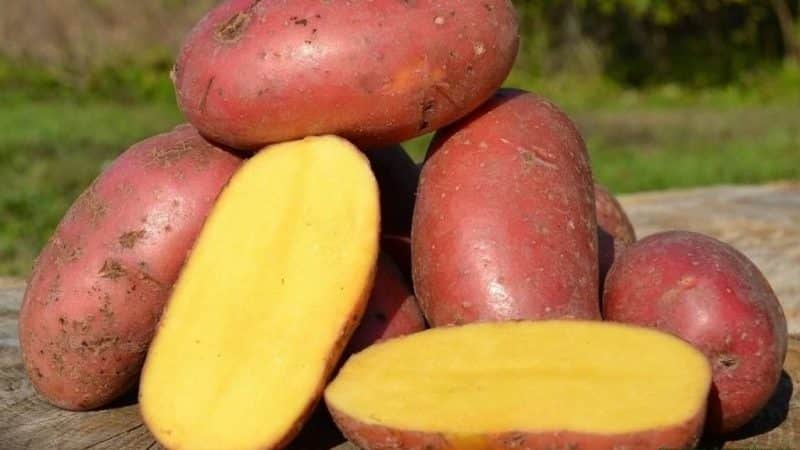Excellent taste of red potatoes: what are their features and what types are there?
Red potatoes with tender flesh are consistently popular among summer residents. Many housewives believe that it makes the most delicious dishes: vegetables are suitable for boiling, frying and baking.
Growing red potatoes is no more difficult than growing yellow or purple ones. It is only important to take into account the characteristics of the chosen variety and follow the general rules of agricultural technology.
Description

Potatoes were brought from Holland by Peter I. The vegetable quickly became an integral part of national dishes in different countries.
Red potatoes are varieties whose tubers have pink or reddish skin.
Their pulp is usually yellow or cream, less often pink (it is healthy itself).
Early ripening varieties
Early potatoes are ready for harvest 40–60 days after planting in the ground. In most cases, such plants have high immunity to nightshade diseases.
Advice! Many gardeners plant early varieties several times a season in order to receive a harvest all summer long.
The taste of these vegetables is not as rich as that of mid- and late-ripening ones. Potatoes have shorter shelf life and low yield.
Early varieties of potatoes with red skin.
Bellarosa
The variety is a German selection and was included in the State Register in 2006. Ready for harvest 60–65 days after planting. The peel is rough red, the flesh is light yellow. Oval-rounded, leveled tubers reach a weight of 200 g. Productivity is 169–326 c/ha.
Bellarosa is drought-resistant, resistant to viral diseases and golden nematode. Suitable for storing for the winter, shelf life - 93%.
Red Scarlet
A variety from Holland, included in the register of varieties approved for cultivation in 2000. The skin of the tubers is red-pink in color, the flesh is yellow. Vegetables are oval in shape and weigh about 100 g.
The crop is characterized by high transportability, productivity (up to 190 c/ha) and resistance to arid climates. Susceptible to late blight.
Borodyansky pink
The variety was bred at the Ukrainian Research Institute of Potato Farming. The peel is red-pink, the flesh is creamy. The tubers are oval in shape, weigh up to 130 g. 2.5–3.7 kg are collected from 1 m2. The crop is susceptible to viral diseases and scab.
Zhukovsky early
Potatoes of domestic selection were included in the State Register in 1993. Productivity is high, 400–450 c/ha. The variety is resistant to cancer, nematode, susceptible to late blight, and undemanding to soil composition. The round-oval tubers are pink, white inside, weigh 100–120 g. Vegetables ripen 2-3 months after planting.

Crimean rose
Pink tubers with creamy pulp ripen in 60–65 days. The vegetables are round, weigh up to 120 g. Productivity is 140–200 c/ha, keeping quality is up to 98%. The variety is moderately resistant to late blight.
Openwork
The culture of domestic selection was entered into the State Register recently, in 2017. Red elongated tubers with creamy pulp weigh up to 130 g. 190–410 centners of vegetables are harvested per hectare. Potatoes are susceptible to nematodes, late blight, and resistant to stripe mosaic, leaf curl, and cancer.
Memphis
Dutch mid-early variety included in the register of approved varieties in 2015. The tubers are elongated, with red skin and light yellow flesh. Weight – 82–160 g. Productivity – 180–400 c/ha.Plants have high immunity to fungal and bacterial diseases.
Carmen
New variety of red potatoes: included in the State Register in 2019. The vegetables are oval with creamy pulp, weighing 100–120 g. Up to 305 centners of harvest are obtained from 1 hectare. The crop is susceptible to late blight on tubers, resistant to cancer, nematode, banded mosaic and leaf curl.
Mid-season varieties
Such varieties have high immunity and productivity, rich taste. Vegetables are harvested after 80–110 days.

Condor
The variety was bred in Holland and entered into the State Register of the Russian Federation in 1995. The tubers are red, elongated, with light yellow flesh, weighing 90–180 g. The yield is average, 184–330 c/ha in the Central region. The condor is affected by late blight, viruses and scab.
Vector
Red round potatoes with yellow pulp, tuber weight - 92-143 g. Productivity - 180-263 c/ha. The variety is undemanding to soil composition, resistant to most diseases, and susceptible to nematodes. The vector was developed in Russia and included in the State Register in 2014.
Rocko
Bred in Austria, added to the State Register in 2002. The tubers are oval red, the flesh is creamy. Weight - 80–120 g. High yield: 136–261 c/ha. The variety is resistant to late blight, nematode, cancer, wrinkled and striped mosaic.
Zhuravinka
Belarusian mid-late variety, included in the State Register of the Russian Federation in 2005. Red peel, yellow flesh, round tubers, weighing 90–140 g. The crop is undemanding in terms of soil composition and moisture, and is resistant to cancer and nematodes.
Symphony
Mid-late potato with red skin and yellow flesh. Average weight - 70–140 g. Productivity - 200–460 c/ha. The variety is susceptible to late blight.
Nakra
A variety of domestic selection, entered into the State Register in 2000.The tubers are red outside, light yellow inside, contain a lot of starch (up to 22%). The weight of potatoes reaches 65–160 g. Up to 400 centners are collected from 1 hectare. The culture is susceptible to late blight and nematodes.
Dolphin
Bred by German breeders, in 2011 included in the register of those admitted to the Russian Federation. Plants have strong immunity to many diseases. The red oval tubers have light yellow flesh and good taste. Average weight - 80–115 g. Productivity - 230–374 c/ha.
Late varieties
Such vegetables have a more pronounced taste, high shelf life and productivity. Immunity is generally lower. Potatoes are harvested after 100–120 days.
Picasso
A variety of Dutch selection, included in the State Register in 1995. Oval yellow tubers with pink spots weigh up to 130 g. Productivity is 193–315 c/ha. The variety is susceptible to late blight; vegetables are suitable for long-term storage.
Zdabytak
Belarusian potatoes are red in color with white flesh, weighing 100–130 g. Contains a lot of starch: 19–25%. Up to 300 centners of tubers are collected from 1 hectare. The variety is moderately susceptible to late blight on the tops, resistant to nematodes and cancer.
Unica
This potato variety is resistant to many diseases. Tubers are oval, uneven. The peel is pink, the flesh is creamy. Up to 400 centners of crops are harvested from 1 hectare.
Berlinka
Mid-late variety of German selection. From 1 hectare they get 220–400 c. Red tubers with white flesh weigh 80–150 g. The crop is resistant to cancer, occasionally affected by rhizoctonia, scab, and susceptible to late blight and ring rot. Plants tolerate drought well.
Chemical composition and KBZHU

Red tubers have the highest calorie content of all potato varieties. Most of its varieties are suitable for both cooking and frying. Per 100 g of product there are 87 kcal, 2.3 g of protein, 1.9 g of carbohydrates, 0.2 g of fat and 1.8 g of dietary fiber. The vegetable consists of 76.7% water (less than the purple and yellow varieties).
Nutrients in tubers:
- vitamins: PP, C, E, D, K, H, B, A;
- sugars: glucose, fructose, sucrose;
- aspartic acid;
- minerals: phosphorus, magnesium, potassium, iron, copper, calcium.
For which regions are they suitable?
Red potatoes are highly drought tolerant. It tolerates hot climates well, but is susceptible to cold snaps.
Pink varieties are recommended for cultivation in the southern and central regions. The climate of the northern regions is not suitable for them.
Main advantages and disadvantages
Advantages of red potatoes:
- rich delicate taste;
- excellent presentation;
- immunity to major diseases;
- versatility in cooking;
- drought resistance;
- nutritional value of tubers.
Culture also has its disadvantages:
- high calorie content of vegetables;
- low resistance to cold weather;
- impossibility of growing in open ground in the northern regions.
Beneficial features
Thanks to their rich composition, potatoes have a number of beneficial properties:
- cleanses the body of bad cholesterol;
- normalizes metabolism;
- activates the gastrointestinal tract;
- has an antioxidant effect;
- reduces ammonia levels in the blood;
- stops inflammatory processes;
- reduces blood pressure;
- strengthens the heart and blood vessels;
- has a diuretic effect.
Features of planting and growing
Agricultural technology for red potatoes is no different from caring for other varieties. This vegetable is undemanding in care, but to obtain a rich harvest, it is important to follow the planting and cultivation technology.
Tuber preparation

Properly selected and prepared planting material is the key to healthy plants and a rich harvest. Gardeners prefer to grow potatoes from tubers.
Their preparation includes several stages:
- Calibration - the tubers are sorted out, leaving hard specimens the size of a chicken egg, with a uniform color, without black spots, cracks, signs of disease, soft areas and other damage.
- landscaping — will increase the viability of planting material and prevent it from becoming infected with infections in the early stages. To do this, the tubers are laid in an even layer on film and placed in a bright place for 2-3 days.
- Disinfection — destroys fungal spores and other infections that often remain on tubers. Planting material is washed in a solution prepared from 1 tsp. copper sulfate and 3 liters of water. Then the potatoes are dried.
- Stimulation of growth - to speed up the germination of tubers, they are soaked in special preparations (for example, in “Solution”).
- Germination - potatoes are folded in one layer in a well-ventilated room with a temperature of +17˚С. Irrigate daily with water at room temperature. They are kept in such conditions for about a month.
- Hardening — sprouted planting material is placed in a place with a temperature of +10˚C for 3 days. This will allow the plants to more easily tolerate temperature changes.
Large tubers are first cut into 2-3 parts so that several sprouts remain on each.
Soil requirements
Potatoes love slightly acidic nutrient soils. The site is located on the sunny side of the garden, where groundwater does not lie too close to the surface.
In the beds where potatoes will grow, no other nightshade crops have been grown during the previous two years.Failure to follow crop rotation rules will lead to soil depletion and increase the risk of plant infection.
The soil is prepared in the fall: it is dug up and mixed with horse, cow manure or humus (6 kg of fertilizer is taken per 1 m2).
To reduce the acidity of the soil, add ash or dry lime to it: 1 tbsp. funds per 1 m2.
Advice! At the end of summer, green manure (rye, lupine) is planted in the beds. In spring, rotted seedlings will make the soil fertile.
In spring, the area is cleared of weeds. For every 1 m2 add 45 g of superphosphate and 1 tbsp. l. potassium sulfate.
Landing scheme and rules
Potatoes are planted in open ground when the air temperature reaches +10˚С. In the southern regions this happens in March, in the central regions in April.
The holes are arranged in rows in a checkerboard pattern. Leave 60 cm between rows and 35–40 cm between bushes.
The most common method of planting potatoes is “under the shovel”. In this case, holes are dug in the ground. Their depth depends on the composition of the soil. In loose soil, tubers are planted at 10–12 cm, in heavy soil – at 4–6 cm.
Advice! The method of planting under straw is also popular: the tubers are placed in holes, but covered not with earth, but with straw. This speeds up the harvest. Disadvantage: straw attracts rodents.
Rules of care
To get a good harvest, it is important to properly care for the plantings.
Basic rules of potato agricultural technology:
- Loosening. The soil is loosened after each watering and weeded. Until the potato seedlings have become stronger, the procedure is carried out 2 times a week: this will prevent the appearance of weeds. Mature bushes independently suppress the growth of other plants in the garden.
- Hilling. The yield of the crop depends on the correctness of its implementation. The plants are earthed for the first time when they reach 15 cm.The soil is raised 6 cm, then a few more every two weeks until the height of the hill reaches 20 cm.
- Feeding. After the formation of 3 true leaves, the first fertilizing is applied (2 kg of mullein per 8 liters of water). The plants are fertilized the second time after the first bud appears: a solution of wood ash is used (1 kg of ash per 1 bucket of water). The last feeding is applied during the period of mass flowering: 45 g of superphosphate and 1 bucket of water.
- Watering. During the entire growing period, the crop is watered no more than 4 times, only in dry summers. Watering is stopped 2 weeks before harvest.
Disease and pest control

Most red potato varieties are resistant to major diseases of the nightshade family.
But sometimes plantings are affected by infections:
- late blight;
- common scab;
- black scab;
- fusarium;
- dry rot;
- ring rot;
- mosaic.
These are fungal (late blight), bacterial (ring rot) and viral (mosaic) diseases. To prevent their appearance, during epidemics, after precipitation, and during cold snaps, plants are sprayed with antifungal and antibacterial agents (Fitosporin, copper sulfate, potassium permanganate solution). Infections usually affect tubers and cannot be treated.
Important! To prevent plantings from becoming infected with mosaic, varieties with genetic immunity are selected, crop rotation rules are followed, planting material is disinfected, and the beds are weeded.
The most common potato pests are Colorado potato beetles. They are collected by hand. A soap solution and a decoction of bitter herbs are used against aphids and spider mites. Wireworms, mole crickets and nematodes can only be dealt with by digging up the soil, removing the larvae and treating the soil with a solution of copper sulfate.
Harvest and storage
Depending on the variety, vegetables begin to be collected from the beginning of July and end in September. In hot climates, young potatoes are produced already at the end of spring. Tubers are dug up with a pitchfork in dry weather. This way they will be clean and will not rot during storage.
Early varieties are not suitable for harvesting for the winter. Mid-season and late varieties retain their taste and beneficial properties until spring.
The harvest is kept in the basement, in wooden boxes or bags. Before this, the vegetables are sorted, sorted by size, and all damaged specimens are removed. The room is pre-fumigated with sulfur.
Read also:
An unpretentious but productive Labella red potato variety.
Potato variety "Krasa" with excellent presentation and excellent taste.
High-yielding, mid-late potato variety “Manifest” with red tubers.
Reviews
Reviews about red potatoes are positive. Many housewives prefer such vegetables.
Irina, Nikopol: “I really like red potatoes, especially Baltic Rose. It is light pink, as in the photo. The tubers are smooth, oval. When growing, I do not use purchased fertilizers. In my opinion, they only bring harm. In the fall, I fertilize the soil well with horse manure and plant rye. In the spring I dig everything up and add a glass of ash to each hole. I use silage and ash as fertilizer.”
Victoria, Belgorod: “I’ve been growing pink potatoes for many years. I really like its delicate taste and beautiful tubers. Alena chose potatoes for herself; the description of the variety corresponds to reality. I plant the crops in bags and get a high-quality harvest.”
Conclusion
Red potatoes are one of the favorite varieties of many gardeners. The tubers have pink skin, cream or yellow flesh, and a delicate and rich taste.The cultivation technology does not differ from the agricultural technology of white varieties.
The main thing is to prepare the planting material correctly, hill up the bushes in a timely manner, apply fertilizers, and follow the watering regime.